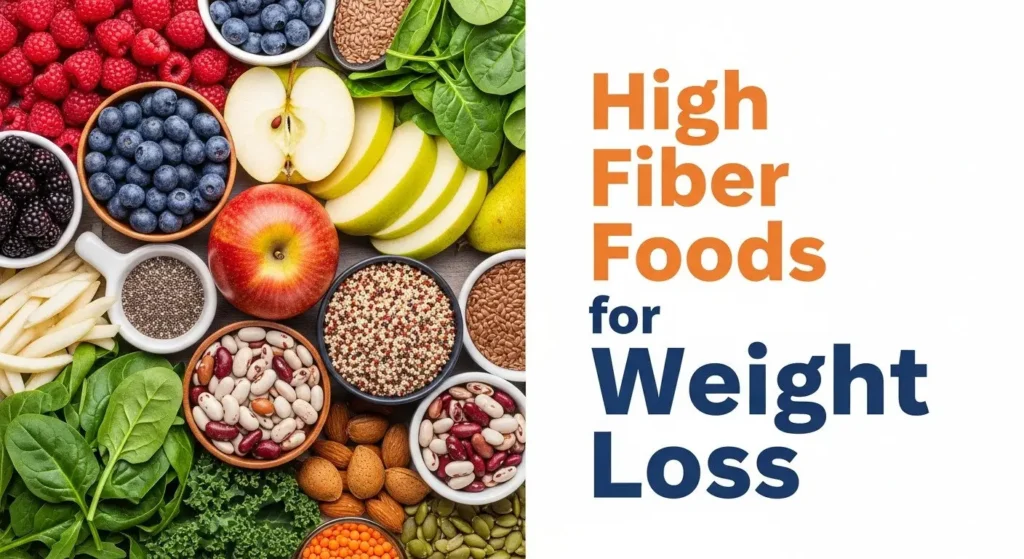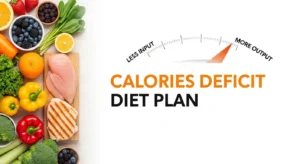Losing weight can feel like a tough journey, but what if a simple change to your diet could make a big difference? Imagine feeling fuller for longer, having better digestion, and seeing the numbers on the scale go down, all by eating delicious foods. That's the power of high fiber foods for weight loss!

More and more people are discovering that adding more fiber to their meals is a smart and effective way to reach their weight loss goals. It's not about complicated diets or expensive supplements; it's about choosing natural, wholesome foods that your body loves. This article will show you how simple high fiber foods for weight loss can help you and keep it off. Get ready to transform your plate and your health!
Key Takeaways
- Fiber Fills You Up: High fiber foods for weight loss help you feel full faster and stay satisfied longer, which naturally leads to eating less and losing weight.
- Boosts Digestion & Gut Health: Fiber keeps your digestive system running smoothly, preventing bloating and supporting a healthy gut, which is key for overall well-being and weight management.
- Stabilizes Blood Sugar: By slowing down sugar absorption, fiber helps prevent energy crashes and cravings, making it easier to stick to your healthy eating plan.
- Easy to Add to Meals: Many everyday foods like fruits, vegetables, beans, and whole grains are packed with fiber and can be easily incorporated into your breakfast, lunch, dinner, and snacks.
- Sustainable Weight Loss: Focusing on fiber-rich foods promotes a balanced, healthy eating pattern that's enjoyable and sustainable for long-term weight management in 2025 and beyond.
Why Fiber is Your Weight Loss Friend
Fiber isn't just good for you; it's a superhero when it comes to weight loss. But what exactly is fiber, and how does it work its magic?
Fiber is a type of carbohydrate found in plant foods that your body can't digest. Unlike other carbs that break down into sugar, fiber passes through your digestive system mostly intact. This unique quality is precisely what makes it so powerful for weight management.
There are two main types of fiber, and both play important roles:
- Soluble Fiber: This type dissolves in water and forms a gel-like substance in your gut. Think of it like a sponge!
- How it helps: It slows down digestion, which helps you feel full longer. It also helps stabilize blood sugar levels and can lower bad cholesterol.
- Found in: Oats, beans, apples, citrus fruits, carrots, barley.
- Insoluble Fiber: This type doesn't dissolve in water. It adds bulk to your stool.
- How it helps: It acts like a broom, pushing waste through your digestive system, preventing constipation and promoting regularity. This can help you feel lighter and less bloated.
- Found in: Whole wheat flour, nuts, beans, green beans, potatoes, and the skins of many fruits and vegetables.
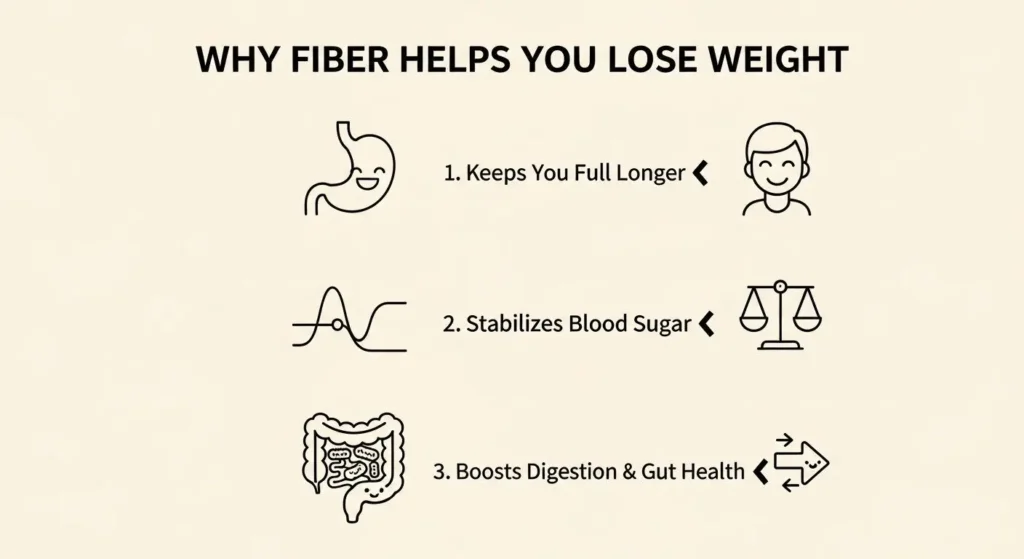
💡 Did You Know?
Most high fiber foods for weight loss contain a mix of both soluble and insoluble fiber, giving you the best of both worlds for weight loss and overall health!
The benefits of fiber extend beyond just feeling full. It supports a healthy gut microbiome (the good bacteria in your intestines), which is increasingly linked to weight management and overall well-being. When your gut is happy, your body works better!
Top Simple High Fiber Foods for Weight Loss Categories
You don't need exotic ingredients to boost your fiber intake. Many everyday foods are packed with this amazing nutrient. Here are the top categories of simple high fiber foods for weight loss that can help you on your weight loss journey in 2025:
1. Fruits
Fruits are nature's candy, offering sweetness along with essential vitamins, antioxidants, and a good dose of fiber. Eating whole fruits (with skins when possible) is key.
- Berries (Raspberries, Blackberries, Blueberries): These tiny powerhouses are bursting with flavor and fiber.
- Example: 1 cup of raspberries has about 8 grams of fiber.
- Apples: A classic for a reason! Always eat the skin for maximum fiber.
- Example: One medium apple has about 4 grams of fiber.
- Pears: Similar to apples, pears are excellent sources of fiber, especially with the skin on.
- Example: One medium pear has about 6 grams of fiber.
- Bananas: While not as high as berries, bananas still offer a good amount of fiber, especially when slightly green.
- Example: One medium banana has about 3 grams of fiber.
- Oranges: Beyond Vitamin C, oranges provide soluble fiber.
- Example: One medium orange has about 3 grams of fiber.
2. Vegetables
Vegetables are the backbone of any healthy diet, and many are fiber champions. They're also low in calories, making them perfect candidate of high fiber foods for weight loss.
- Leafy Greens (Spinach, Kale, Collard Greens): Don't let their light weight fool you; they add bulk and fiber to your meals.
- Example: 1 cup cooked spinach has about 4 grams of fiber.
- Cruciferous Vegetables (Broccoli, Brussels Sprouts, Cabbage): These veggies are superstars for both fiber and nutrients.
- Example: 1 cup of cooked broccoli has about 5 grams of fiber.
- Root Vegetables (Sweet Potatoes, Carrots): Naturally sweet and satisfying, these provide both soluble and insoluble fiber.
- Example: One medium sweet potato (with skin) has about 4 grams of fiber.
- Artichokes: One of the highest fiber vegetables!
- Example: One medium artichoke has about 7 grams of fiber.
3. Legumes (Beans, Lentils, Chickpeas)
Legumes are incredibly versatile, affordable, and packed with both fiber and plant-based protein, making them excellent for satiety and muscle health.
- Black Beans: Great in salads, soups, or as a side.
- Example: 1 cup cooked black beans has about 15 grams of fiber.
- Lentils: Cook quickly and are perfect for stews, soups, or as a meat substitute.
- Example: 1 cup cooked lentils has about 16 grams of fiber.
- Chickpeas (Garbanzo Beans): Enjoy them roasted, in hummus, or added to curries and salads.
- Example: 1 cup cooked chickpeas has about 13 grams of fiber.
- Kidney Beans: Hearty and delicious in chili or bean salads.
- Example: 1 cup cooked kidney beans has about 13 grams of fiber.
4. Whole Grains
Unlike refined grains (like white bread or white rice), whole grains keep their bran, germ, and endosperm intact, which means they retain all their fiber and nutrients.
- Oats: A fantastic breakfast choice, especially steel-cut or rolled oats.
- Example: 1 cup cooked oatmeal has about 4 grams of fiber.
- Quinoa: A complete protein and a great source of fiber.
- Example: 1 cup cooked quinoa has about 5 grams of fiber.
- Brown Rice: A healthier alternative to white rice.
- Example: 1 cup cooked brown rice has about 3.5 grams of fiber.
- Whole Wheat Bread/Pasta: Make sure the label says “100% whole wheat” or “whole grain.”
- Example: 2 slices of whole wheat bread have about 4 grams of fiber.
- Barley: Excellent for soups and stews.
- Example: 1 cup cooked barley has about 6 grams of fiber.
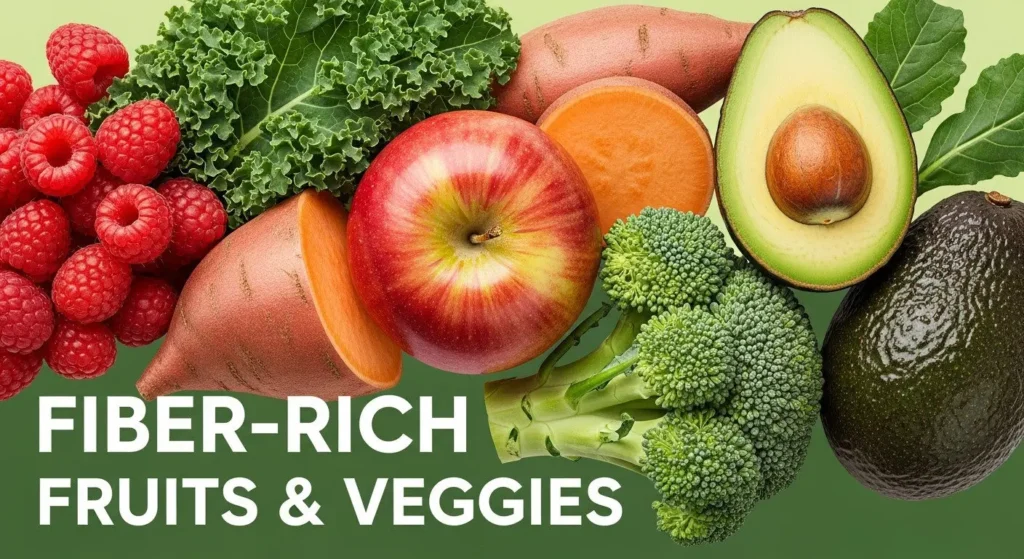
5. Nuts & Seeds
Nuts and seeds are calorie-dense, so portion control is important, but they offer healthy fats, protein, and a significant amount of fiber.
- Chia Seeds: One of the most fiber-rich foods on the planet! They absorb liquid and form a gel.
- Example: 2 tablespoons of chia seeds have about 10 grams of fiber.
- Flaxseeds: Also very high in fiber and healthy omega-3s. Best consumed ground.
- Example: 2 tablespoons of ground flaxseeds have about 4 grams of fiber.
- Almonds: A great snack that provides fiber and healthy fats.
- Example: 1 ounce (about 23 almonds) has about 3.5 grams of fiber.
- Pistachios: Another good snack option.
- Example: 1 ounce (about 49 pistachios) has about 3 grams of fiber.
“Eating fiber-rich foods is like giving your body a natural advantage in the weight loss game. It's simple, satisfying, and sustainable.”
How Fiber Helps You Lose Weight Fast
Understanding how fiber impacts your body can motivate you to include more of it. It's not just a general “healthy” food; it has specific mechanisms that promote high fiber foods for weight loss.
1. Super Satiety: Feeling Full, Longer
This is perhaps the biggest reason that high fiber foods for weight loss is champion.
- Bulk: Fiber adds volume to your meals without adding many calories. This bulk takes up space in your stomach, signaling to your brain that you're full.
- Slow Digestion: Soluble fiber forms a gel that slows down the emptying of your stomach. This means food stays in your stomach longer, keeping hunger at bay for hours.
- Less Snacking: When you feel satisfied after meals, you're less likely to reach for unhealthy snacks between meals, which is crucial for cutting down on overall calorie intake.
2. Blood Sugar Stability: No More Cravings
High-fiber foods, especially those rich in soluble fiber, help to manage your blood sugar levels.
- Gradual Absorption: Fiber slows down the absorption of sugar into your bloodstream. This prevents rapid spikes and crashes in blood sugar.
- Reduced Cravings: When your blood sugar is stable, you avoid the sudden drops that trigger intense cravings for sugary or high-carb foods. This makes it easier to make healthier food choices.
- Insulin Sensitivity: Over time, a diet rich in fiber can improve your body's sensitivity to insulin, which is beneficial for weight management and overall metabolic health.
3. Digestive Health & Regularity: Feel Lighter
A well-functioning digestive system is important to high fiber foods for weight loss.
- Waste Elimination: Insoluble fiber adds bulk to your stool and helps it move through your intestines more quickly, preventing constipation and promoting regular bowel movements. This can make you feel lighter and less bloated.
- Gut Microbiome: Fiber acts as a prebiotic, feeding the beneficial bacteria in your gut. A healthy gut microbiome is linked to better weight management and reduced inflammation.
- Detoxification: By promoting regular elimination, fiber helps your body get rid of waste and toxins efficiently.
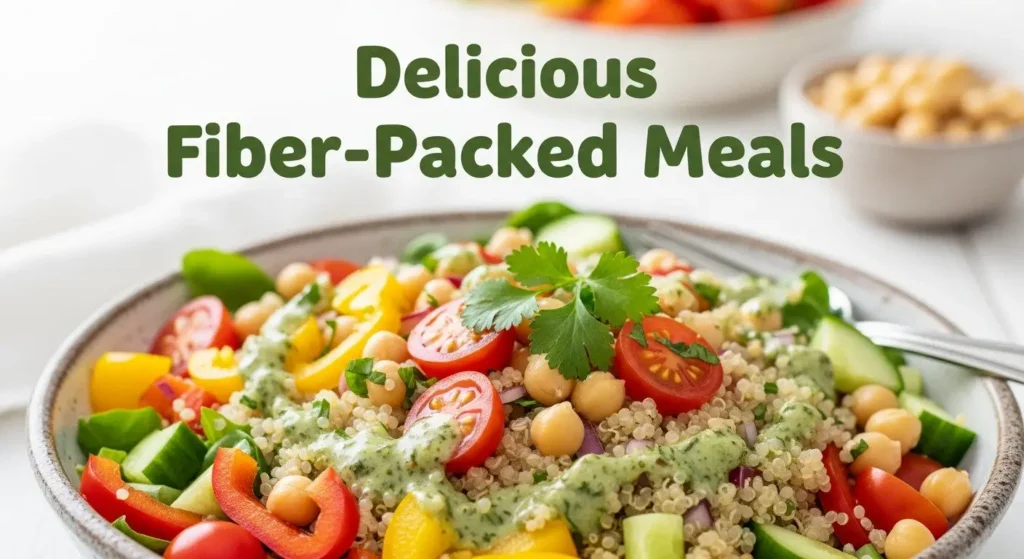
4. Calorie Control: Naturally Eating Less
Because fiber-rich foods are filling and often lower in calories per serving, they can help you reduce your overall calorie intake without feeling deprived.
- Nutrient Density: High-fiber foods are typically nutrient-dense, meaning they provide a lot of vitamins, minerals, and antioxidants for relatively few calories. This ensures you're nourishing your body while cutting calories.
- Mindful Eating: When you choose whole, fiber-rich foods, you naturally tend to eat more mindfully and appreciate the food more, which can prevent overeating.
Incorporating Fiber into Your Daily Meals
Making fiber a staple in your diet doesn't have to be complicated. Here are simple ways to boost your intake throughout the day:
Breakfast Ideas
- Oatmeal Power-Up: Start your day with a bowl of oatmeal. Mix in berries (fresh or frozen), a tablespoon of chia or flax seeds, and a few chopped nuts.
- Whole-Grain Toast: Opt for 100% whole wheat toast with avocado and a sprinkle of everything bagel seasoning, or with a thin layer of nut butter and sliced banana.
- Smoothie Boost: Add a handful of spinach (you won't taste it!), a tablespoon of flax seeds, and some berries to your morning smoothie.
Lunch Ideas
- Super Salad: Build a big salad with a base of leafy greens (spinach, kale), add various colorful veggies like bell peppers, cucumbers, and carrots, and top with roasted chickpeas or lentils for extra fiber and protein.
- Hearty Soup/Chili: Make a large batch of lentil soup or bean chili with plenty of vegetables. These are great for meal prepping!
- Whole-Wheat Wrap/Sandwich: Fill a whole-wheat wrap or sandwich with plenty of vegetables like lettuce, tomatoes, cucumbers, and roasted bell peppers, along with a source of lean protein.
Dinner Ideas
- Bean-Based Dishes: Try a black bean burger, lentil shepherd's pie, or a chickpea curry.
- Veggie-Loaded Stir-Fry: Use brown rice as your base and load up on broccoli, snap peas, carrots, and other fiber-rich vegetables.
- Sweet Potato Power: Serve baked sweet potatoes as a side dish instead of white potatoes, topped with a dollop of Greek yogurt and chives, or a black bean and corn salsa.
Snacks
- Fruit & Nut Combo: An apple with a small handful of almonds, or a pear with walnuts.
- Veggie Sticks & Hummus: Carrot sticks, celery, or bell pepper strips with a serving of hummus (made from chickpeas!).
- Edamame: Steamed edamame in the pod is a delicious and fiber-rich snack.
- Popcorn: Air-popped popcorn (without too much butter or oil) is a whole grain and surprisingly good for fiber.
Fiber-Rich Meal Ideas & Recipes
Here are some simple, delicious meal ideas that pack a fiber punch:
| Meal Type | Recipe Idea | Key High-Fiber Ingredients |
|---|---|---|
| Breakfast | Berry Chia Pudding | Chia seeds, mixed berries (raspberries, blueberries), almond milk, touch of maple syrup |
| Lunch | Mediterranean Quinoa Salad | Quinoa, chickpeas, cucumber, tomatoes, bell peppers, spinach, olive oil, lemon juice |
| Dinner | Lentil & Vegetable Curry | Lentils, sweet potatoes, spinach, cauliflower, onions, garlic, ginger, curry spices |
| Snack | Apple Slices with Peanut Butter & Flax Seeds | Apple, natural peanut butter, ground flax seeds |
👩🍳 Quick Tip: Batch cook grains like quinoa or brown rice, and legumes like lentils or black beans at the beginning of the week. This makes adding fiber to meals incredibly easy!
Tips for Increasing Fiber Intake Safely
While fiber is fantastic, it's important to increase your intake gradually to avoid digestive discomfort like bloating or gas. Your body needs time to adjust!
- Go Slow: Don't go from 0 to 50 grams overnight. Start by adding one extra high-fiber food to your daily diet for a few days, then another.
- Drink Plenty of Water! 💧: This is CRITICAL. Fiber needs water to do its job effectively. Without enough water, fiber can actually cause constipation instead of preventing it. Aim for 8-10 glasses of water a day.
- Read Labels: Look for “fiber” on nutrition labels. Aim for foods with at least 3-5 grams of fiber per serving.
- Choose Whole Over Juice: Eat whole fruits and vegetables instead of drinking their juice. Juicing removes most of the beneficial fiber.
- Leave Skins On: Whenever possible, eat the skins of fruits and vegetables like apples, pears, potatoes, and cucumbers, as they contain a lot of fiber.
- Swap Wisely:
- White rice ➡️ Brown rice or quinoa
- White bread ➡️ Whole-wheat bread
- Sugary cereal ➡️ Oatmeal
- Meat in chili ➡️ Beans and lentils

Common Mistakes to Avoid
Even with the best intentions, some common pitfalls can derail your fiber-rich journey:
- Increasing Too Quickly: As mentioned, this can lead to uncomfortable bloating, gas, and cramping. Gradual is key!
- Not Drinking Enough Water: Fiber absorbs water. If you increase fiber but not water, you're asking for trouble (i.e., constipation).
- Relying Solely on Fiber Supplements: While supplements can be helpful, they don't offer the full spectrum of nutrients that whole foods do. Prioritize food sources.
- Ignoring Portion Sizes for Calorie-Dense Fiber Foods: Nuts, seeds, and avocados are high in fiber but also high in calories. Enjoy them, but be mindful of your portions, especially when aiming to high fiber foods for weight loss.
- Expecting Instant Results: While fiber helps you lose weight faster by improving satiety and digestion, it's part of a healthy lifestyle, not a magic pill. Consistency is what truly works.
Fiber and Gut Health Connection
The link between high fiber foods for weight loss, gut health, and overall wellness is becoming clearer. Your gut is home to trillions of bacteria, collectively known as the gut microbiome. These bacteria play a huge role in how you digest food, absorb nutrients, and even how your body stores fat.
- Prebiotic Effect: Many types of fiber, especially soluble fiber, act as prebiotics. This means they are food for the beneficial bacteria in your gut. When these good bacteria thrive, they produce short-chain fatty acids (SCFAs) like butyrate, which have anti-inflammatory effects and can positively influence metabolism and appetite control.
- Diverse Microbiome: A diet rich in various types of fiber encourages a diverse gut microbiome, which is associated with better health outcomes and a lower risk of obesity.
- Reduced Inflammation: An unhealthy gut can lead to chronic inflammation, blocking weight loss. Eating high fiber foods for weight loss helps create a gut environment that reduces inflammation.
By nourishing your gut with fiber, you're not just helping your digestion; you're creating an internal environment that supports sustainable weight loss and overall vitality.
Beyond Fiber: A Holistic Approach to Weight Loss
While high fiber foods for weight loss are incredibly powerful for weight loss, they are most effective when part of a broader, healthy lifestyle. Think of fiber as a cornerstone, but not the entire building.
For truly sustainable results, consider these other crucial elements:
- Balanced Healthy Diet: Fiber is part of this! Ensure you're getting enough lean protein, healthy fats, and a variety of fruits and vegetables. Learn more about creating a balanced healthy diet for weight loss.
- Healthy Eating Habits: It's not just what you eat, but how you eat. Mindful eating, portion control, and regular meal times are key. Dive deeper into healthy eating for weight loss.
- Regular Physical Activity: Exercise burns calories, builds muscle (which boosts metabolism), and improves mood. Find activities you enjoy and make them a regular part of your week.
- Adequate Sleep: Lack of sleep can disrupt hormones that control appetite, leading to increased hunger and cravings. Aim for 7-9 hours of quality sleep per night.
- Stress Management: Chronic stress can lead to increased cortisol levels, which can promote fat storage, especially around the belly. Find healthy ways to manage stress, like meditation, yoga, or spending time in nature.
- Sustainable Weight Loss Plans: For long-term success, you need a plan that fits your lifestyle. Explore different healthy weight loss plans and healthy weight loss programs to find what works for you. Remember, the best healthy weight loss diet is one you can stick to!
By combining the power of high fiber foods for weight loss with these other healthy habits, you'll not only achieve your weight loss goals but also build a foundation for lasting health and well-being.
Conclusion
Embracing simple high fiber foods for weight loss is one of the most effective and sustainable strategies. From the satisfying crunch of an apple to the hearty goodness of a lentil stew, these foods naturally help you feel fuller, stabilize your blood sugar, and keep your digestive system happy.
Remember, it's not about deprivation, but about nourishing your body with delicious, wholesome ingredients. By gradually adding high fiber foods for weight loss, staying hydrated, and combining this approach with other healthy lifestyle choices, you'll be well on your way to achieving your goals and enjoying a healthier, more vibrant you. Start small, be consistent, and watch as the power of fiber transforms your health!


